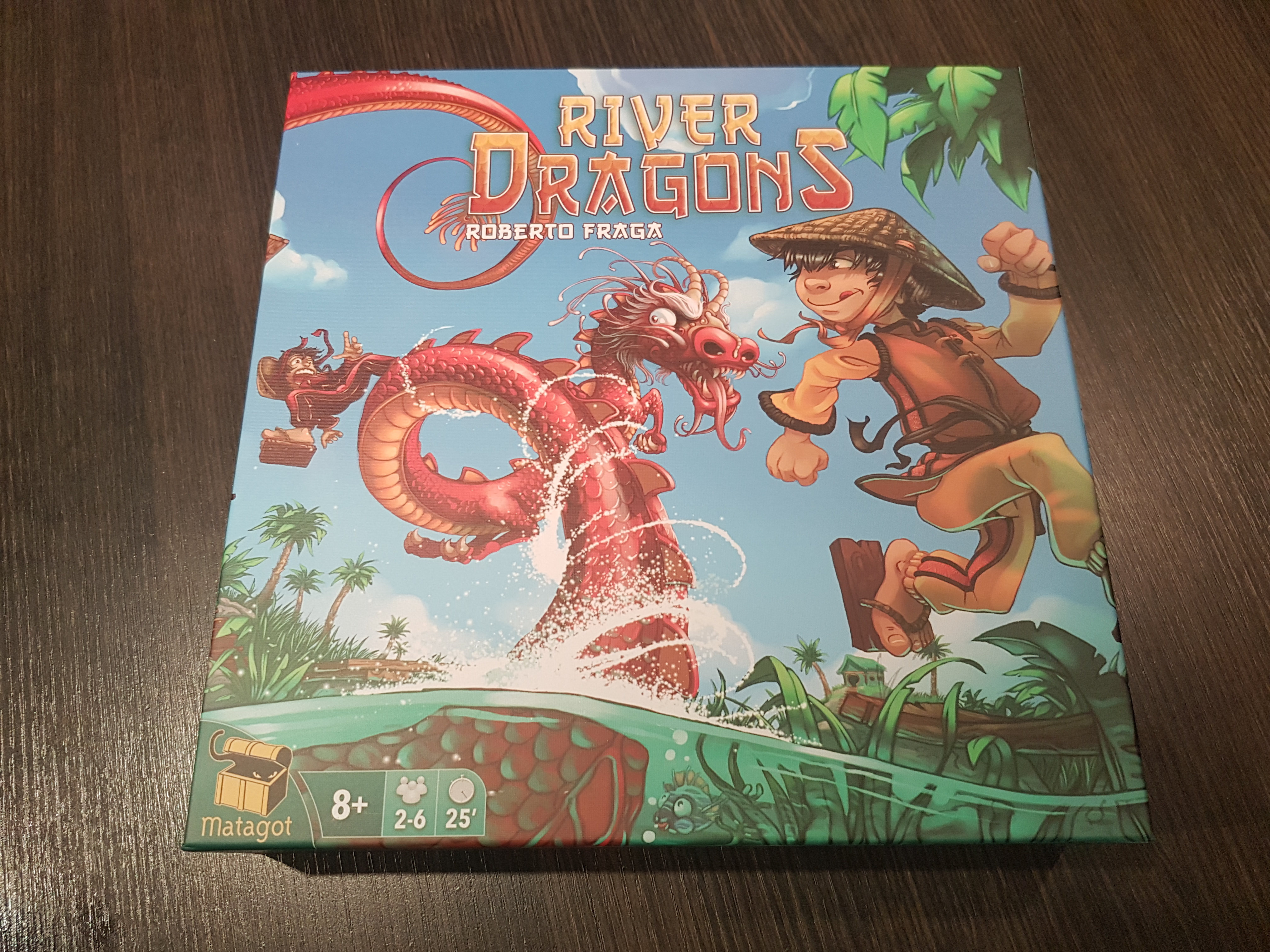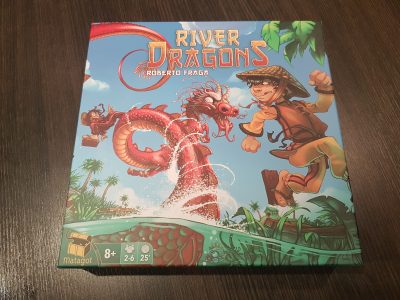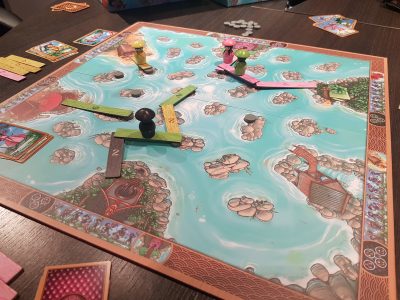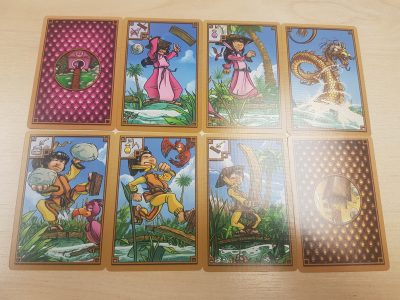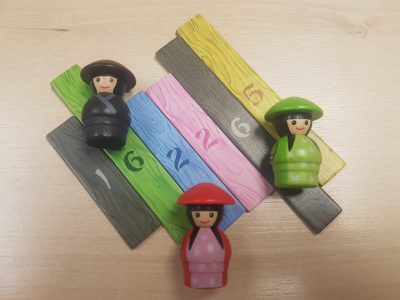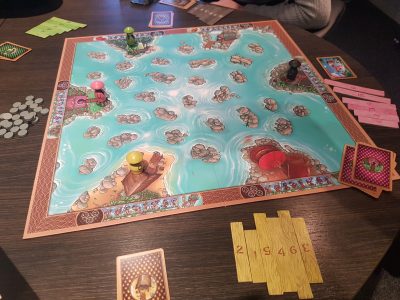River Dragons is the brand new programing game from Roberto Fraga where villagers are venturing to cross the mighty Mekong delta. The game is designed for 2 – 6 players and takes around 30 minutes to play, however with new players at the full headcount the time can rise to around 35-40 minutes. Villagers must get from a starting location to the opposite village first to receive the golden dragon and be victorious. To get there they must use the rocks in the river and wooden planks to make the crossing.
Programming truly is the epitome of a boring sounding genre but it is a great structure to blend bluffing and the determining others moves together. Players have at their disposal a range of simple actions that will help them either get closer to their destination village or screw over an opponent. Before getting any planks down players must put stones on the rocks in the river, planks can then be placed from stone to stone or village to stone. There are two actions that allow players to do this one allowing placement of one stone and another two stones. Note that each rock can only have one stone token at a time, so you can make things harder for opponents by placing them out of reach. The reason for this is when placing planks each player starts with 6 different length planks. Like the stones there are two actions one for adding one plank and one for two planks.
To win the game you can put down all the planks you can but you still need to get to the destination village. There are three movements available to players: a single plank, two planks movement and jump. The first two are relatively self-explanatory and means the player must move to either an adjacent unoccupied plank or two planks away, the caveat is that you cannot pass through other players’ characters. Jump allows you to leap frog an opponent’s character, though it is risky. If no one is there you end up in the river and must start from the beginning.
Two actions remain and are focused at stopping your opponents in their river crossing attempts. These are both commonly used throughout the game, but you have to balance personal progression with hampering opponents. The first allows you to remove a single stone or plank from the board, as long as there isn’t a plank on it or character piece on it respectively. This can seriously throw people’s plans into the drink! The other is just as effective but doesn’t alter the board. Each player has Dragon cards the colour of the playing opponents. Play one of these and if they follow you in that turn of cards their action is cancelled unless it is also a dragon.
Why is this important? At the start of each round players will choose five actions to take and the order which they want them to occur. Once selected starting with the first player, each will turn over one card at a time and complete that action. Dragons and removing planks can disrupt plans. Take the scenario where a player has the idea of building a plank then walking one plank onto it. If someone removes the plank before that player’s second action they might have to walk backwards away from their destination. The key to any programming genre game is the action must take place if possible even if it is detrimental to the player playing it. After the five actions have taken place, everyone picks their cards back up and chooses a new set of five actions. This continues until someone reaches their destination.
The rulebook, or more accurately rule sheet, keeps things short and to the point. It does a great job at getting the rules of the game across, while giving examples of the actions available to players. The majority of the rules are incredibly easy to pick up, with a few actions having conditions to maintain the flow and balance of the game. As a result, players of all ages and prior gaming experience can play and enjoy. River Dragons certainly falls into the light game category and is perfect for introducing new players to the hobby and those family members whom struggle with complicated rulesets. Despite this, it’s cute style and ease of play will see it come out at other times when light-hearted, non-complex fun is on the menu.
The first few rounds give the game a slow start. What is helpful for new players becomes an almost insignificant drag in every subsequent game. The first game new players can be stepped into how things work. Allowing them to make sure they are using actions correctly while making progress. The issue is in the games that follow the first few actions are mostly identical with players having to get stones and planks onto the board. We trialled a couple of tweaks and the best result was before the game starts each player placed a single stone. Instantly, variation was added to the first few turns. Some still opted to place stones, while others placed planks and those spiteful enough had a choice of whether to remove a stone or a plank. This just got players into the action quicker when they had already played a game.
Other programming board games use a mechanics of special cards and I feel this is something that River Dragon would benefit from. This is the concept of a card, or cards, which you cannot play repeatedly. The dragons, for example, are very powerful to disrupt an opponent’s move. If once played it couldn’t be picked up until the end of the subsequent round the power would be slightly dissipated and using the dragons would feel more precious. This may add extra weight to the game and I feel the developers aimed to make a simple, easy to pick up and play, experience. Maybe this rule doesn’t work with this mentality. However, I’ll probably look to try it out in the future, with the right gaming group.
The artwork of the River Dragon game board is stunning. The bright cartoony styled village buildings at the sides next to the light blues of the swirling water really set the scene of the river crossing. The small Koi swimming in the water that you don’t notice at first glance show the love put into the artwork. All of this gorgeous artwork is bordered by and intricate pattern that is only broken to house player reminders and objectives. The helps those new to the game remember what actions are available and which distinctly different village they are aiming for.
River Dragon’s isn’t only accessible due to its ruleset. The colours used offer a good variety but are also bright and vibrant. This helps the light-hearted and fun nature of the board game shin through. The inclusion of male and female character cards pushes the game forward to be more inclusive to all gamers. Even aside from this, it is nice to see a slight variation between the artwork of the six sets of action cards: three featuring a male character and the same amount a female character. As a game perfectly angled to be an entry game, it is great to see inclusion being a key feature to be inviting for all to play and get them into the hobby.
As with other programming games River Dragons can carry some weight to those new to the hobby or younger gamers. Any confusion is thankfully dispelled after a turn or two allowing River Dragons to become an amazing gateway game to show people there is a world out there past Monopoly. The loveable, cute theme and fast gameplay will help people jump in and play. This works perfectly with the light-hearted nature of the game which will see planks removed just before you wanted to use them. River Dragons won’t keep hardcore gamers entertained for hours at a time but even those grumpy family members will struggle not to enjoy a quick game from time to time!
[Editor’s Note: River Dragons was provided to us by Esdevium Games for review purposes. The game is currently available on 365 Games for £27.49. It is also available from local UK board game stores, find your local store here]

